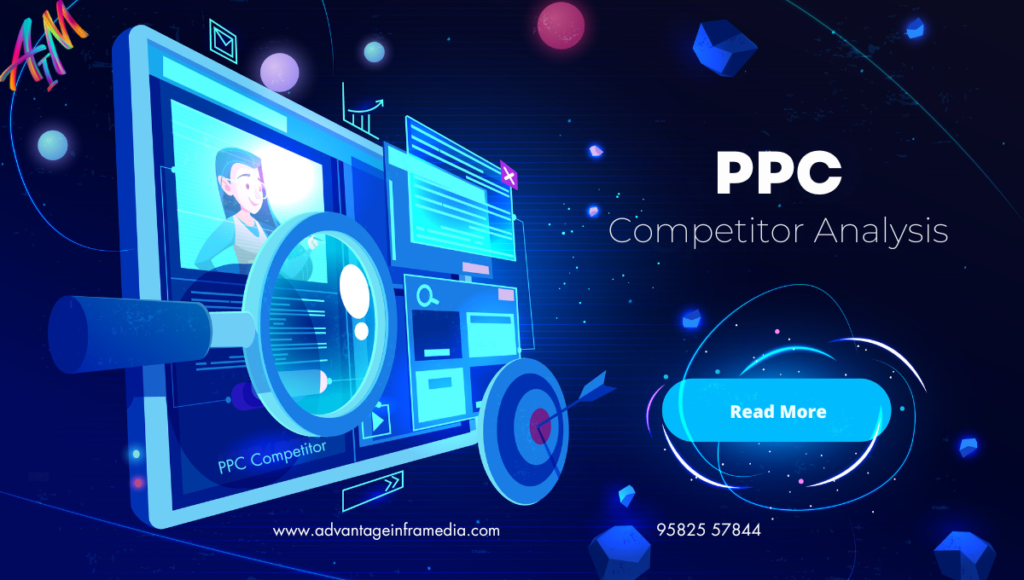Introduction
PPC (Pay-Per-Click) advertising has become one of the most effective digital marketing strategies. It allows businesses to reach a highly targeted audience and generate leads with measurable ROI. However, the competition in (PPC competitor) can be fierce, and to stay ahead, conducting a thorough PPC competitor analysis is essential. This analysis not only provides insight into your competitors’ strategies but also uncovers opportunities for you to outperform them in the digital marketing space.
This blog will guide you through the process of conducting a PPC competitor analysis and highlight how it represents a massive opportunity in digital marketing. From understanding the fundamentals to employing advanced tactics, we’ll break down every step you need to master.
What Is PPC Competitor Analysis?
PPC competitor analysis is the process of researching, analyzing, and understanding the (PPC competitor) strategies of your competitors. This includes investigating their ad spend, keywords, ad copy, bidding strategies, landing pages, and overall performance. By analyzing this data, you can identify their strengths and weaknesses, uncover gaps in their strategies, and ultimately craft a more effective (PPC competitor) campaign.
Why PPC Competitor Analysis Is Critical
- Identify Opportunities: Competitor analysis can reveal keyword gaps, underutilized ad formats, and new targeting methods.
- Understand Market Positioning: Gain insights into how competitors position their products and services through their ads.
- Optimize Ad Spend: By understanding the bidding strategies of competitors, you can avoid costly mistakes and maximize the efficiency of your ad spend.
- Improve Ad Copy: Observing the messaging that resonates with your competitors’ audience allows you to refine your own.
- Boost Quality Score: A higher quality score leads to lower costs and better ad placements, and learning from your competitors’ mistakes can help you achieve this.
Step-by-Step Guide to Conducting a PPC Competitor Analysis
Identify Your Competitors
The first step is to identify who your competitors are in the (PPC competitor) landscape. These might not always align with your organic SEO competitors, as different companies may dominate paid searches.
- Use PPC Tools: Tools like SEMrush, SpyFu, and Ahrefs can help you identify who is bidding on the same keywords.
- Manual Search: Perform a manual search using your target keywords to see which companies appear in the ads.
- Consider Niche Competitors: Don’t just focus on the big players; niche competitors may provide unique insights.
Analyze Competitors’ Keywords
Keywords are the foundation of any (PPC competitor) campaign. Analyze which keywords your competitors are bidding on to understand their strategy.
- Paid vs. Organic Keywords: Identify which keywords they are targeting in paid search versus organic.
- Identify High-Performing Keywords: Tools like Google Keyword Planner can show which keywords have high search volumes and competition levels.
- Long-Tail Keywords: Competitors may be using long-tail keywords to capture more specific searches, offering a less competitive and cost-effective strategy.
- Negative Keywords: Investigating your competitors’ negative keywords can reveal areas where they are avoiding wasteful ad spend.
Investigate Ad Copy and Creatives
The ad copy and creatives are crucial in converting users. Analyze the messaging, tone, and call-to-actions (CTAs) used by your competitors.
- Ad Headlines: Look at the headlines to see what grabs attention and resonates with the target audience.
- Description Text: Study the description text for clarity, benefits, and emotional triggers.
- Ad Extensions: Investigate if they are using sitelink extensions, callout extensions, or structured snippets to enhance their ads.
- Visual Ads: In the case of display or social (PPC competitor) campaigns, pay attention to the visuals, such as images and videos, and analyze the design and messaging.
Evaluate Bidding Strategies
Competitor bidding strategies can give you insight into how aggressive or conservative their (PPC competitor) campaigns are. This information is key to understanding their overall marketing strategy.
- CPC (Cost Per Click): Tools like SpyFu can show you the estimated CPC for specific keywords and give you a sense of how much your competitors are willing to spend.
- Bid Modifiers: Look at how your competitors adjust bids based on device, location, or time of day.
- Auction Insights: Google Ads provides Auction Insights, which can help you compare your performance with that of your competitors for the same keywords.
Examine Landing Pages
The landing page is where conversions happen. Analyzing competitors’ landing pages is essential to understand their approach to conversion optimization.
- User Experience (UX): Evaluate the design, speed, and overall usability of their landing pages.
- Call-to-Action: Analyze the strength and clarity of their CTAs and how prominently they are placed.
- Messaging Consistency: Ensure the messaging on the landing page aligns with the ad copy for a seamless user experience.
- Form Optimization: Examine how they structure forms—short forms often convert better, but long forms can generate more qualified leads.
Monitor Competitors’ Ad Performance
You can estimate your competitors’ ad performance by monitoring their ad placements, engagement rates, and overall visibility.
- Impression Share: Tools like Google Ads and SEMrush can show you how often your competitors’ ads appear in search results.
- Ad Frequency: Observe how frequently your competitors run ads for specific keywords.
- Click-Through Rate (CTR): Estimate your competitors’ CTR by looking at their ad copy and positioning to gauge how effectively they are engaging their audience.
Track Competitors’ Budget and Ad Spend
Understanding your competitors’ budget allocation for (PPC competitor) campaigns can reveal their priorities and market aggressiveness.
- Estimated Spend: Tools like iSpionage and SpyFu can give you an estimate of your competitors’ monthly ad spend.
- Budget Allocation: Observe how they split their budget across different channels like Google Ads, Bing Ads, and social media platforms.
- Seasonal Changes: Track any seasonal spikes in ad spend to understand how competitors adjust their budget throughout the year.
Uncover Competitors’ Remarketing Strategies
Remarketing allows businesses to target users who have previously visited their website but didn’t convert. Studying competitors’ remarketing strategies can help you uncover new tactics to re-engage potential customers.
- Display Ads: Examine the frequency and placement of remarketing ads on the Google Display Network (GDN) or social media platforms.
- Ad Personalization: Look at how personalized their remarketing ads are based on the audience segments.
- Remarketing Duration: Try to infer how long your competitors’ ads are running after a user visits their website.
Tools for PPC Competitor Analysis
Several tools can assist in conducting a comprehensive PPC competitor analysis. Here are some of the most popular ones:
- SEMrush: Offers detailed insights into competitors’ keywords, ad copies, and spend estimates.
- SpyFu: Provides information on competitors’ ad history, keyword performance, and bidding strategies.
- Ahrefs: Though primarily an SEO tool, it offers valuable data on (PPC competitor) keywords and competitor analysis.
- Google Auction Insights: Offers direct comparison data on how your ads perform against competitors in Google Ads.
- iSpionage: A tool that tracks (PPC competitor) campaigns and reveals keyword and ad performance data.
Best Practices for PPC Competitor Analysis
Regular Monitoring
Competitors’ PPC strategies change frequently. Regular monitoring is crucial to stay on top of their latest tactics and adjust your campaigns accordingly.
Focus on Direct and Indirect Competitors
Don’t limit your analysis to direct competitors only. Indirect competitors can offer valuable insights into keyword targeting, audience segmentation, and bidding strategies.
Segment Your Competitors
Divide competitors into different categories based on factors such as ad spend, industry, and market share. This helps you tailor your analysis to the most relevant competitors.
Leverage Competitor Weaknesses
Identify gaps or weaknesses in your competitors’ strategies, such as poor landing page design or under-optimized keywords, and capitalize on those areas.
Combine PPC with SEO Data
PPC and SEO often go hand-in-hand. Combining insights from both areas can provide a more holistic understanding of your competitors’ digital marketing strategies.
How PPC Competitor Analysis is the Biggest Opportunity in Digital Marketing
In a crowded digital marketing landscape, standing out requires more than just a good campaign. PPC competitor analysis provides the data-driven insights necessary to refine your strategy and gain an edge over the competition. By regularly conducting this analysis, you can optimize your ads for better performance, lower costs, and higher conversions.
- Uncover Hidden Gaps: Competitor analysis helps you identify underutilized keywords, ad formats, and targeting methods that can give you an advantage.
- Refine Your Strategy: It allows you to fine-tune your (PPC competitor) campaigns based on proven tactics and avoid costly mistakes.
- Stay Agile: (PPC competitor) is a fast-paced environment, and competitor analysis ensures that you stay agile and responsive to industry shifts.
- Maximize ROI: By improving ad relevance, reducing wasted spend, and identifying new opportunities, PPC competitor analysis ultimately helps boost ROI.
Advanced Strategies for PPC Competitor Analysis
As digital marketing evolves, so do the strategies used by competitors to gain a competitive edge. While the fundamental steps of PPC competitor analysis—such as keyword research, ad copy analysis, and landing page evaluation—are crucial, advanced strategies can take your analysis to the next level. These strategies allow you to uncover deeper insights that can reveal long-term trends, emerging opportunities, and hidden tactics your competitors may be using.
Competitor Segmentation by Audience Targeting
One advanced tactic is to segment your competitors by the type of audience they are targeting. Understanding how competitors are dividing their target markets helps in aligning your PPC strategy with the most profitable audience segments.
- Demographics: Look at the age, gender, and location your competitors target. Tools like Facebook Ad Library provide insights into which demographics are being targeted in social ads.
- Interest-Based Targeting: Analyze if your competitors are using interest-based targeting, which focuses on specific hobbies, lifestyle choices, or behaviors.
- Device Targeting: Competitors may use different strategies for desktop vs. mobile users. Tools like Google Analytics and SEMrush can show device-specific performance data.
- Geotargeting: If your competitors are focusing on specific regions or countries, it can reveal untapped markets where you can dominate with less competition.
Identify Competitor Funnel Strategies
Competitor analysis is not just about keywords and bids; it’s also about understanding the full customer journey. Identifying and analyzing the sales funnel your competitors use can offer valuable insights into how they guide users from initial awareness to final conversion.
- Top of the Funnel (TOFU): Analyze content that targets new users unfamiliar with the brand, such as educational blog posts, eBooks, or awareness-stage ads.
- Middle of the Funnel (MOFU): Look for comparison tools, case studies, or webinar ads that move prospects toward consideration.
- Bottom of the Funnel (BOFU): Examine the final conversion points—whether through product demos, free trials, or heavy discount offers.
- Content Strategy: Competitors may integrate content marketing within their (PPC competitor) strategy, and understanding this can help you align your content and ad efforts.
Analyze Seasonality in Competitor Campaigns
Seasonality can play a massive role in (PPC competitor) performance, particularly in industries like retail, travel, and finance. Observing how your competitors shift their campaigns around holidays, major events, or other key times of the year can give you a clear indication of their priorities and budgeting practices.
- Ad Spend Fluctuations: Tools like SpyFu can show how competitors increase or decrease their ad spend during specific seasons.
- Keywords Trends: Google Trends allows you to track keyword popularity across different times of the year. You can also see if competitors are capitalizing on seasonal trends that you may have overlooked.
- Seasonal Offers and Discounts: Competitors may offer time-sensitive promotions to increase urgency, especially around major shopping seasons like Black Friday or Christmas.
Competitor Use of Automation and AI
With advancements in artificial intelligence (AI) and automation, more businesses are using machine learning to optimize their (PPC competitor) campaigns. Observing how your competitors are incorporating automation can reveal opportunities for you to enhance your own campaigns.
- Automated Bidding: Are your competitors using automated bidding strategies like Target CPA (Cost Per Acquisition) or Target ROAS (Return on Ad Spend)? This can be identified by the frequency and placement of their ads in different positions.
- Dynamic Search Ads: Dynamic search ads automatically generate headlines based on user search queries. If competitors are using these, it suggests a reliance on automation to broaden keyword targeting without manual input.
- Ad Copy Variations: AI-driven tools like Google’s Responsive Search Ads generate multiple versions of ad copy. By analyzing the different variations competitors run, you can gain insights into their experimentation with AI-generated content.
Cross-Channel Competitor Analysis
A holistic (PPC competitor) strategy often extends beyond Google Ads to other platforms such as Facebook, Instagram, LinkedIn, and even YouTube. Competitors who advertise across multiple platforms create a stronger digital presence, and analyzing their cross-channel efforts can provide you with crucial information on where to allocate your budget.
- Social Media Ads: Investigate how competitors are using Facebook and Instagram Ads. Are they promoting visual content such as videos or carousels? What kind of engagement rates are they achieving?
- LinkedIn Ads: B2B companies often use LinkedIn for targeted professional audiences. Look for sponsored content, InMail ads, or lead gen forms in your competitors’ strategies.
- YouTube Ads: Video advertising is increasingly important. Competitors using YouTube may focus on pre-roll ads or display ads to target users based on their viewing habits.
- Synergy with Organic Marketing: Investigate whether competitors are integrating their (PPC competitor) strategy with organic efforts like SEO, influencer marketing, or social media. This synergy can lead to more cohesive campaigns, better visibility, and stronger brand awareness.
Reverse Engineer Competitors’ A/B Testing
A/B testing is critical for optimizing (PPC competitor) campaigns, and your competitors are likely running tests on their ads. By reverse-engineering their A/B testing efforts, you can uncover what resonates with their audience and apply those findings to your own campaigns.
- Ad Copy Variations: Competitors may test different headlines, CTAs, or benefits in their ads. By analyzing which versions are shown more often (using tools like SEMrush or Adbeat), you can infer which ones perform best.
- Landing Page Tests: Competitors frequently test landing pages to determine the optimal layout, form placement, or messaging. Monitoring changes in their landing pages over time can give you clues about what works.
- Experimentation with New Ad Formats: If competitors are experimenting with new ad formats (e.g., responsive ads, video ads, or interactive elements), they may be testing user engagement rates.
Track Changes in Competitors’ Strategy Over Time
Competitors are constantly refining their strategies, and keeping an eye on these changes can help you stay ahead of the curve. Tracking historical data is an advanced tactic that offers valuable long-term insights.
- Historical Keyword Data: By tracking which keywords competitors have targeted over time, you can identify trends in their strategy. For example, if a competitor consistently increases bids on certain keywords during specific times of the year, you can prepare to counter that.
- Landing Page Evolution: Monitor changes to landing pages over time, including changes in layout, content, and CTAs. This can help you understand how competitors are adapting to improve conversion rates.
- Ad Copy Shifts: Competitors frequently update their ad copy to reflect changes in consumer behavior, seasonal demands, or new promotions. Keeping tabs on these updates provides insights into how they stay relevant.
Competitors’ Use of Audience Segmentation
Audience segmentation is one of the most advanced aspects of PPC competitor analysis. By analyzing how your competitors segment their audience based on behavior, interests, or demographics, you can craft more targeted campaigns that resonate with specific customer groups.
- Remarketing Lists: Competitors may create remarketing lists based on users who visited certain pages, interacted with certain content, or took specific actions. Tools like Google Analytics can help you infer these strategies based on competitors’ ad placements.
- Affinity Audiences: Affinity audiences are segments of users with a long-term interest in specific topics. Check whether your competitors are using affinity audience targeting and which topics they prioritize.
- Lookalike Audiences: If competitors use Facebook or Google Ads, they may rely on lookalike audiences to expand their reach. Analyze which high-conversion audiences they are modeling their campaigns on.
The Future of PPC Competitor Analysis
As PPC advertising continues to grow in complexity, the importance of competitor analysis will only increase. Emerging technologies like AI, automation, and machine learning are transforming how businesses approach PPC, and staying ahead of these trends requires constant vigilance and adaptation. Here’s how PPC competitor analysis is poised to evolve:
AI-Driven Insights
AI tools are beginning to play a significant role in analyzing vast amounts of competitor data and delivering actionable insights. In the future, expect AI to automate the process of collecting, organizing, and analyzing data on competitors’ ad spend, keyword strategies, and audience targeting.
- Predictive Analytics: AI can help predict competitors’ next moves based on historical data and market trends.
- Real-Time Analysis: With AI-powered tools, businesses can get real-time updates on competitor strategies, allowing for faster adjustments to their own PPC campaigns.
Voice and Visual Search
Voice search and visual search are gaining traction, especially with the rise of smart assistants like Amazon Alexa, Google Assistant, and Apple’s Siri. Competitor analysis in this area is still in its infancy, but it will become increasingly important as these technologies become mainstream.
- Voice Search Keywords: Analyzing how competitors are optimizing for voice search queries will be crucial in the coming years.
- Visual Search: Platforms like Pinterest and Google Lens are introducing visual search features, and tracking competitors’ efforts in this space will help identify new opportunities.
Data Privacy and Regulation Impact
With tightening data privacy regulations like GDPR and CCPA, competitor analysis is becoming more complex. Advertisers will need to stay compliant while still gathering insights from their competitors. Tools and methodologies may shift as data privacy becomes a larger concern.
- First-Party Data Focus: As third-party cookies are phased out, competitors may rely more heavily on first-party data. Analyzing how competitors collect, segment, and leverage their own data will be critical.
- Privacy-Friendly Tools: (PPC competitor) tools will need to evolve to continue offering valuable insights without violating user privacy.
Conclusion
In conclusion, PPC competitor analysis is not just a one-time activity but a dynamic and ongoing process. By employing both basic and advanced strategies, businesses can uncover hidden opportunities, avoid costly mistakes, and stay ahead of their competition. The landscape of digital marketing is rapidly evolving, and those who are vigilant in monitoring and adapting to competitor strategies will be the ones who succeed. Whether you’re leveraging historical data, analyzing competitors’ audience segmentation, or diving deep into seasonal trends, the insights gained through a comprehensive competitor analysis can transform your (PPC competitor) campaigns and drive significant business growth.
Post Views: 38




